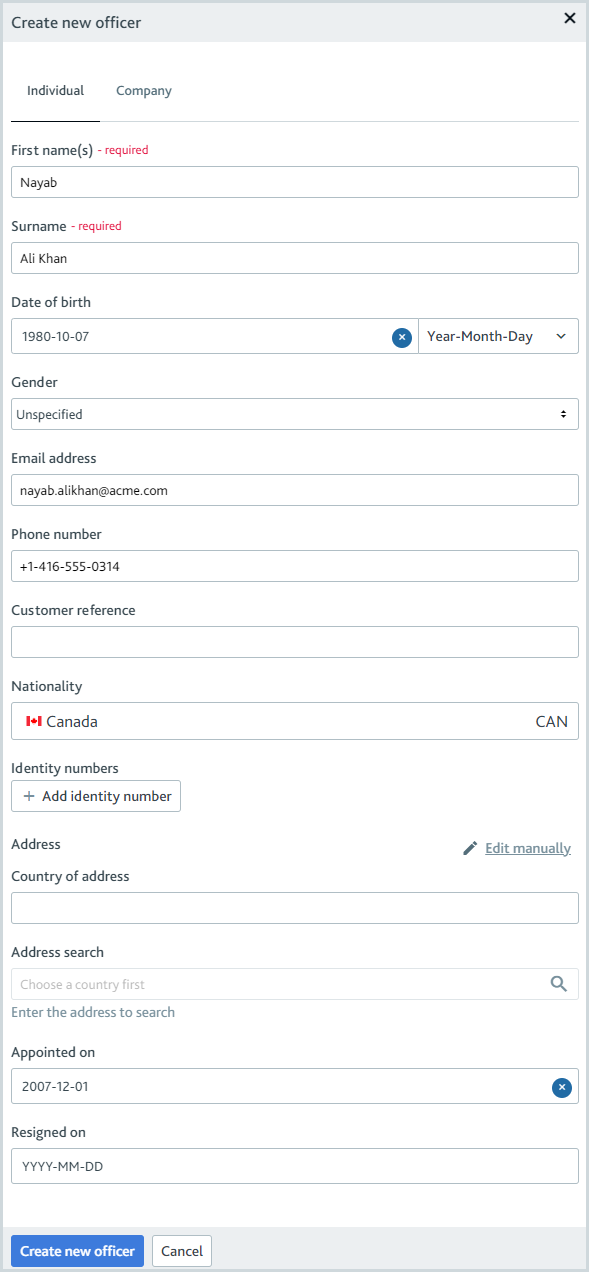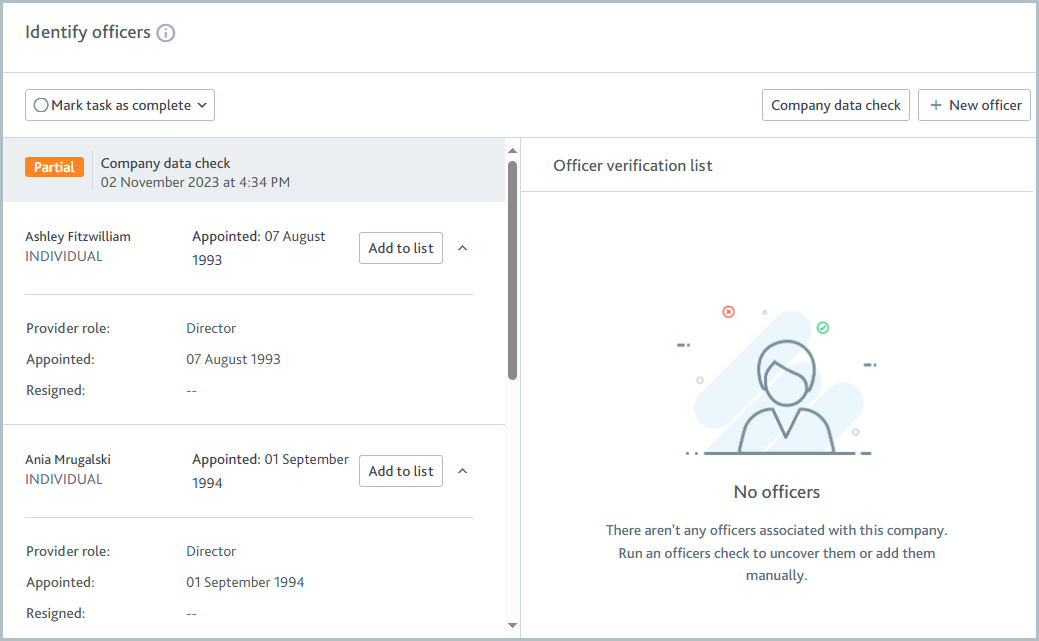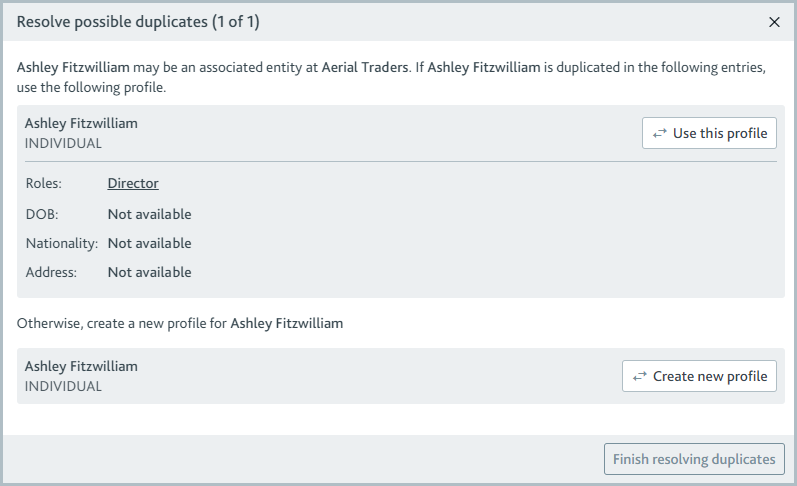Add company associates to a verification list
Associates can be added to a verification list manually or from an imported list. They can be individuals or companies.
It is not possible to import a list of authorized persons. Authorized persons are always added manually. You can add up to ten levels of associates to a company profile.
Add associates manually
Whether using automated checks or not, you can always manually add an associate.
To add an associate to a verification list manually:
Select the add button before the verification list.
On the Officers verification list, the button is .

On the Shareholders and Ownership verification lists, it’s .
On the Trustees verification list, it’s .
On the Authorized persons verification list, it’s .
If the associate is a person, select . If the associate is a company, select .
Authorized persons are always individuals.
Complete the fields provided. Any required fields are marked required.

Select the button.
On the Officer verification list, the button is .
On the Shareholder and Ownership verification lists, it’s .
On the Trustee verification list, it’s .
On the Authorized persons verification list, the button is .
The associate is added to the verification list.
A profile is created for the individual or company so they can be verified and approved as an associate. To learn more, see About the associates verification list.
If a similarly named profile is already linked to the parent profile, the Resolve possible duplicates dialog is displayed. For more information, see Resolve possible duplicates.
If you're adding an officer with a resignation date, you'll be asked to confirm that you want to add them.
Once you’ve added an associate to the verification list, you can copy details from an imported associate to the associate you added. To learn how, see Copy information from imported associates.
Add associates from an imported list
You can run a check that returns a list of officers, shareholders, beneficial owners, or trustees from your data provider and any available information about them.
Once associates are imported into Passfort, they can be added to a verification list automatically or manually.
Import a list of associates
The type of check you can use to import associates depends on the task.
Identify officers: Use the Company data check or the Company registry check to import a list of key decision-makers at the board level, for example, directors and company secretaries, and any available information about their roles; the dates they were appointed, the dates they resigned, and their dates of birth. Active officers are displayed at the beginning of the results and resigned officers at the end.
Identify shareholders: Use the Company data check or the Company ownership check to import a list of key shareholders with significant voting rights and control, plus any available information about the percentage of shares each one holds. Shareholders with the greatest share percentage are displayed at the beginning of the results.
Identify trustees: Use the Company registry check to import a list of key decision-makers at the board level, for example, chairs and secretaries, and any available information about their roles, the dates they were appointed, and the dates they resigned.
Assess company ownership: Use the Company data check to import a list of entities with ownership and control of the onboarded company.
Note
Authorized persons cannot be imported using a check.
When associates are imported, they're displayed on the left side of the task.

In the case of the Identify officers task, each officer only has either their appointment date or resignation date displayed next to their name. The appointment date is displayed when the officer is still active. The resignation date is displayed when the officer has resigned. To see a resigned officer's appointment date and provider role, click the officer's name to expand their details.
If an officer has multiple roles, note that you'll only see a resignation date if the officer is resigned from all roles. If the officer is active in any role, the appointment date is displayed. For example, if the officer was the company director from 1980-1990 and the corporate secretary from 1985 to the present day, you'll see Appointed: 1980. To see the appointment dates and, if available, resignation dates for all roles, click the officer's name.
If some of the information can't be found, for example, if the associate does not have a resigned date because they're still active at the company, -- is displayed.
You can configure a task so its checks run automatically when the task is first added to a profile and whenever a new version of the task is added.
When you run a check, a permanent record of the results is kept on the profile so you always have a "snapshot" of what happened. This means if you re-run a check to import a list of company associates, the new list is displayed before the older lists. The same associates may appear on both lists.
Add associates from an imported list automatically
You can configure tasks to add associates from an imported list to a verification list automatically.
When adding to the list automatically, there is a limit of 100 direct associates.
The following associates never get added to a verification list by automatic addition: Resigned officers, company secretaries, officers with a role of Other, and shareholders with an unknown share percentage.
The values for the Automatic addition to the verification list option are:
Automatic addition is disabled: No associates are added to the verification list automatically. When this value is used, the only way to add associates to the verification list is to do so manually. Learn how to add associates manually.
Add all profiles: Every associate returned by the data provider is added to the verification list.
Add up to a specific number of profiles: When configuring the task, you specify a number. Up to this number of associates imported from the data provider are added to the verification list.
The Assess company ownership, Identify officers, Identify shareholders, and Identify trustees tasks control how associates are added to the verification list.
Add profiles with a percentage of shares greater than or equal to a threshold: For the Identify shareholders or Assess company ownership tasks only. When you specify a percentage of shares, all shareholders who own this percentage and above are added.
Add profiles with selected roles: For the Assess company ownership task only. You can add associates imported from the data provider with the following roles to the verification list: Beneficial owner, global ultimate owner, or controlling shareholder.
If the check returns a Partial match, no associates are added to the verification list automatically.
When an associate is added to a verification list automatically, Passfort checks the associate’s full name to see if they already have a profile as part of the product application. Associates already have profiles when they're on other verification lists. For example, an associate may be a director on the Officers verification list and a beneficial owner on the Shareholders verification list for the same company. If an associate has an existing profile for the application, a second profile is not created. Instead, the verification list links to the existing profile.
Add associates from an imported list manually
To add an associate from the imported list manually, click the button next to the associate’s name.

The associate is added to the verification list.
A profile is created for the individual or company so they can be verified and approved as an associate. To learn more, see About the associates verification list.
If a similarly named profile is already linked to the parent profile, the Resolve possible duplicates dialog is displayed. For more information, see Resolve possible duplicates.
Resolve possible duplicates
If an individual or company has two profiles, they may need to complete the same due diligence tasks more than once.
Associates may already have a profile when they are on multiple verification lists for the same product application. For example, if an associate is a director and a beneficial owner of the company, they will appear on the Officers verification list and the Shareholders verification list.
If an associate you’re adding to the verification list is closely matched to one or more individuals/companies with similar details, when you add the associate to a verification list manually, the Resolve possible duplicates dialog is displayed so you can ensure only one profile is created for the associate.

This dialog is only displayed for associates added to the verification list manually. When associates are added to the verification list automatically, their duplicates are resolved automatically. For more information, see Add associates from the imported list automatically
In the dialog, a check mark is displayed next to any profile data that are the same, and an x is displayed next to any profile data that are different.
If the associate is a duplicate of one of the associates listed, select next to the duplicate, then select . The verification list links to your selected profile and no second profile is created.
If the associate is not listed here, select , then . A new profile is created for the associate. The verification list links to the new profile.